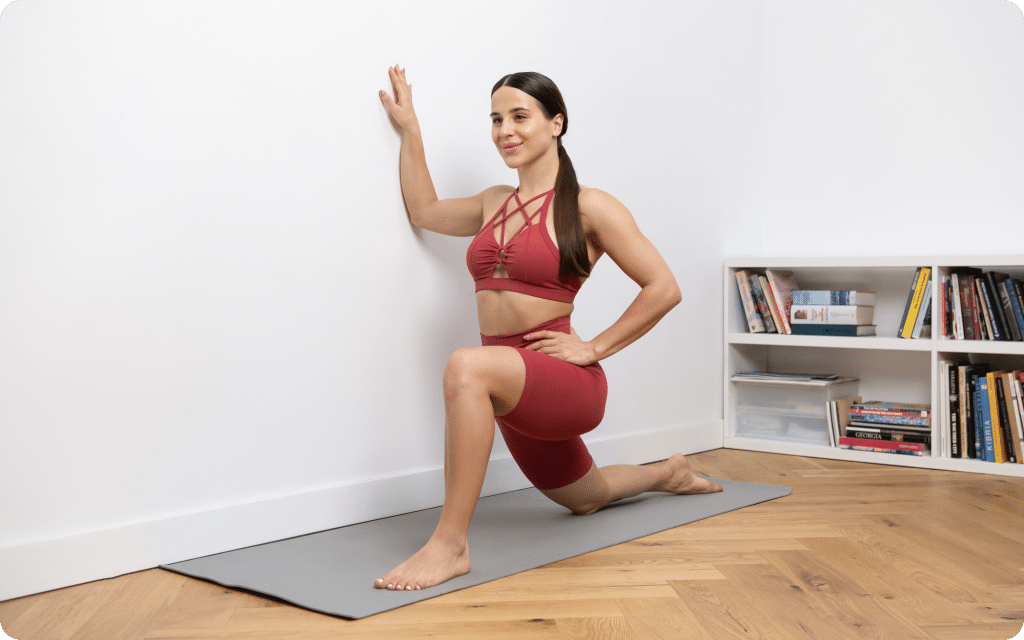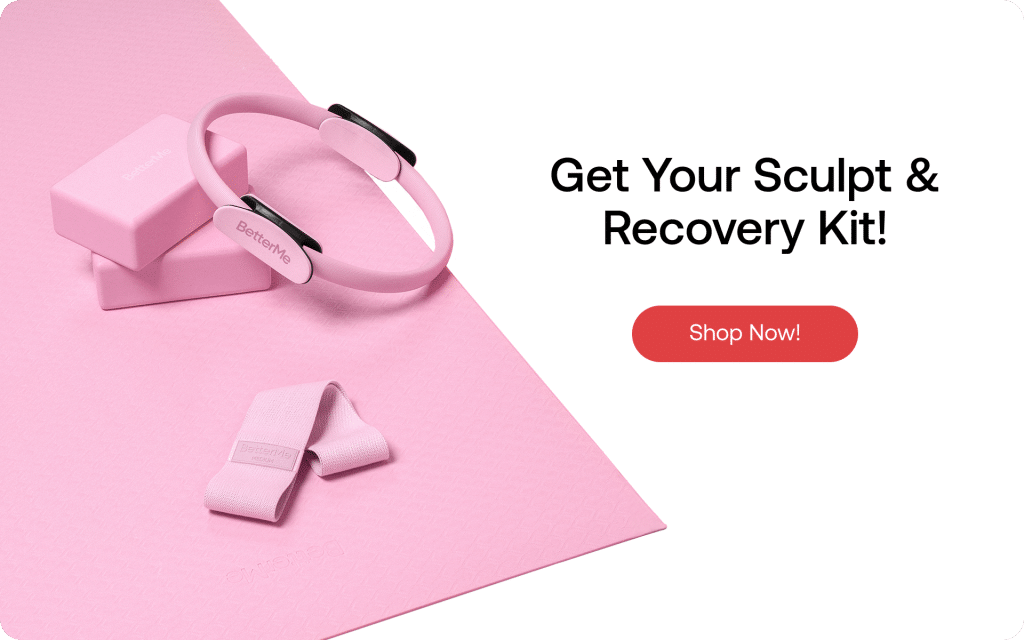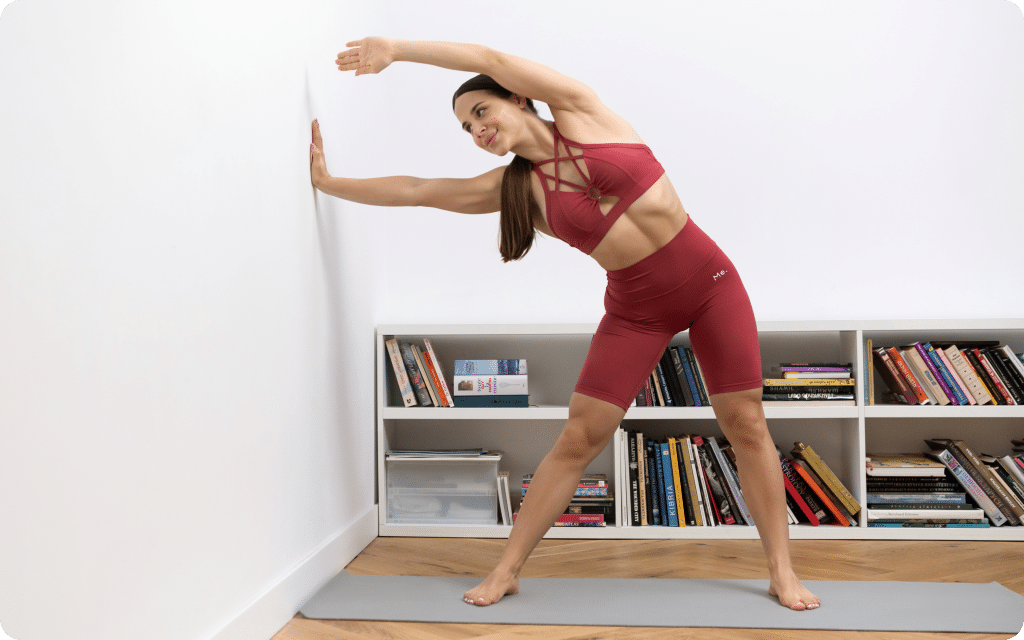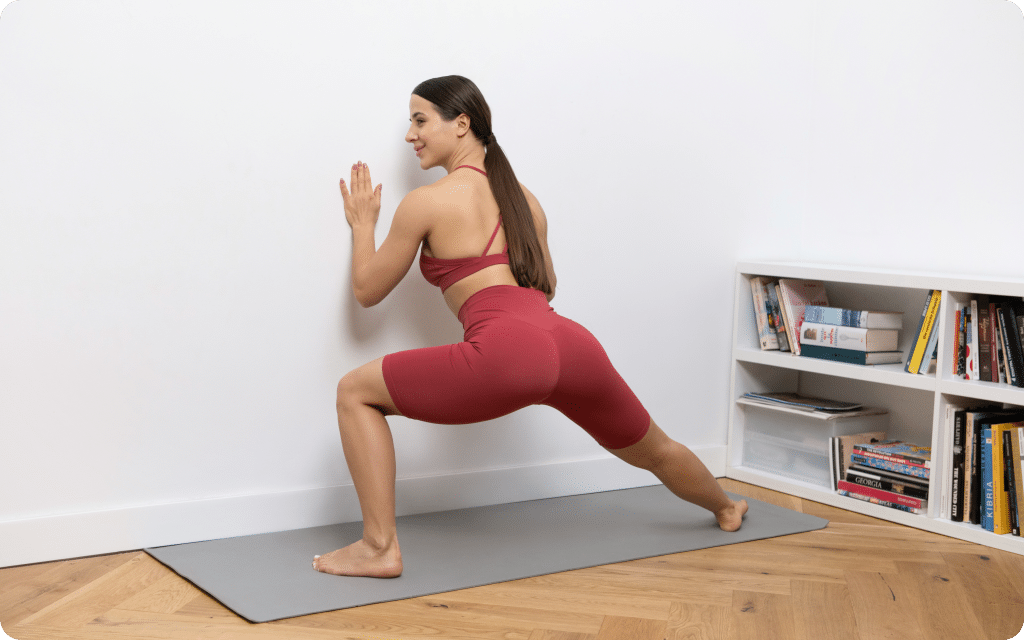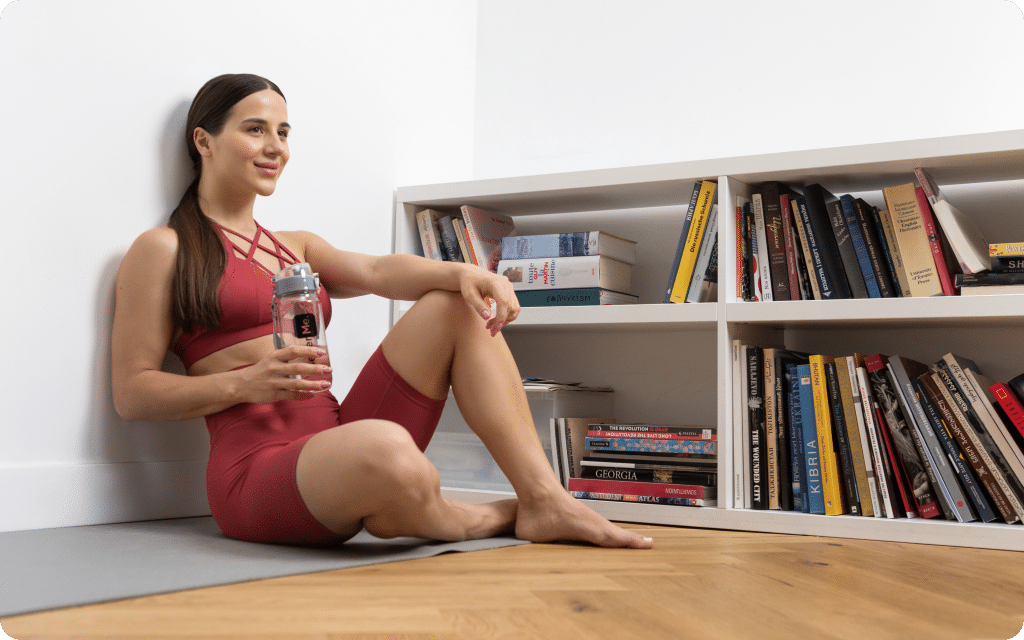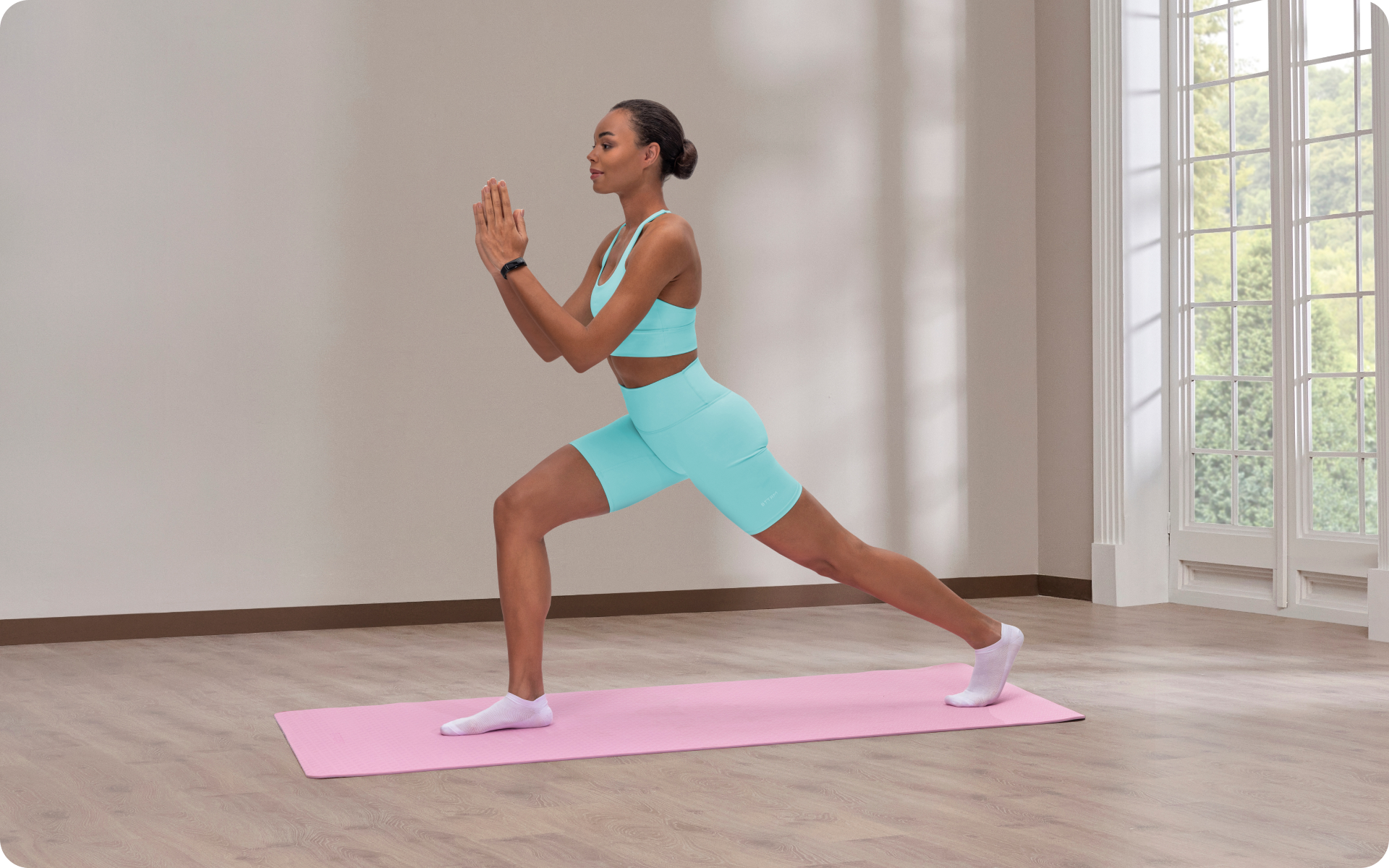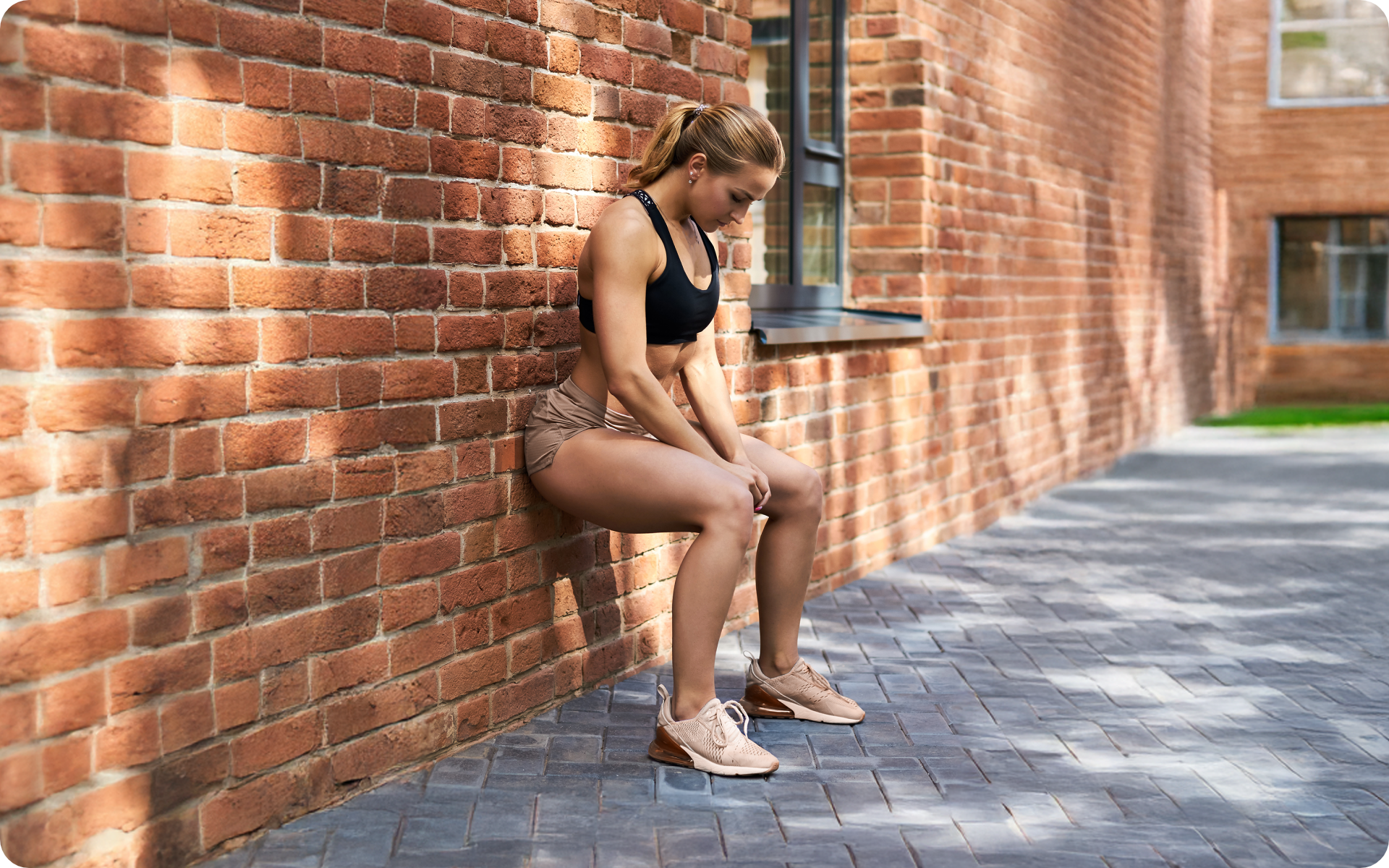Imagine living in a world where 81% of the global population leads a sedentary lifestyle, and the average person spends over 10 hours every day sitting. According to the World Health Organization, we live in a world where modern conveniences and demanding work schedules have caused us to abandon our body’s natural movement patterns (4). But what if we told you that there’s a way to counteract this alarming trend and unlock your body’s full potential? Introducing Wall Pilates – an innovative program designed to help you reconnect with your primal instincts, improve posture, and enhance overall well-being. Not sure how to get started? Read this guide.
What Is A Wall Pilates Program?
A Wall Pilates program is a unique and highly effective exercise regimen that combines the principles of traditional Pilates with the support and resistance of a wall.
This innovative approach addresses the limitations of conventional Pilates by offering enhanced stability and control, making it suitable for individuals of all fitness levels. Let’s dive deeper into the world of Wall Pilates and explore its numerous benefits.
The Foundation Of Wall Pilates
Wall Pilates is based on the core principles of traditional Pilates, which include:
Here’s a brief explanation of the core principles of traditional Pilates (5):
- Concentration: This principle emphasizes the importance of mental focus during Pilates exercises. By concentrating on each movement, you can achieve better control and form, leading to more effective workouts.
- Control: Control refers to the ability to maintain proper body alignment and execute precise movements throughout each exercise. It involves engaging the right muscles and avoiding unnecessary strain on other parts of the body.
- Centering: In Pilates, the “center” or “powerhouse” consists of the muscles in the abdomen, lower back, hips, and buttocks. Centering involves engaging these muscles to provide stability and support for all other movements in the exercise routine.
- Flow: Flow is the smooth transition between exercises, creating a continuous and fluid movement pattern. This principle helps improve coordination and ensures that the entire body works together harmoniously during the workout.
- Precision: Precision focuses on performing each exercise with accuracy and attention to detail. By prioritizing quality over quantity, you can maximize the benefits of each movement and prevent injuries.
- Breathing: Proper breathing is essential in Pilates, as it helps to oxygenate the muscles and facilitate better concentration and control. Deep, coordinated breaths are encouraged throughout the exercises to promote relaxation and maintain the flow of movements.
Read More: Make Your Own Wall Pilates Exercise Chart With Detailed Instructions For Each Type Of Exercise
The Wall: Your Ultimate Support System
The primary difference between traditional Pilates and Wall Pilates lies in the use of a wall as a support system.
The wall provides:
- Stability: It allows you to maintain balance and proper alignment during exercises.
- Resistance: The wall acts as an opposing force, enabling you to engage your muscles more effectively.
- Versatility: You can perform a wide range of exercises, targeting various muscle groups, using only the wall as your equipment.
How Does A Wall Pilates Program Work?
A typical Wall Pilates program is structured to provide a comprehensive workout, targeting various muscle groups and addressing different aspects of fitness.
Here’s a more detailed look into how a Wall Pilates program works:
Warm-Up Exercises
A Wall Pilates session begins with a series of gentle warm-up exercises that last for about 5-10 minutes. These movements help increase blood flow, loosen up the muscles, and prepare your body for the upcoming workout (2).
Some common warm-up exercises include wall push-ups, standing leg swings, and shoulder rolls.
Core Exercises
The main part of a Wall Pilates program consists of core exercises lasting around 30-40 minutes. These exercises focus on strengthening and stabilizing your core muscles, including the abdominals, lower back, hips, and glutes.
Examples of core exercises are wall planks, wall squats, and standing leg lifts. Each exercise is typically performed in sets of 8-12 repetitions, with short breaks between sets.
Targeted Exercises
In addition to core exercises, Wall Pilates also incorporates targeted movements that focus on specific areas of the body, such as the arms, legs, and upper back. These exercises help improve overall muscle balance, flexibility, and functional strength.
Examples include wall tricep presses, standing calf raises, and wall angels.
Cool-Down Exercises
A Wall Pilates session concludes with a cool-down period lasting about 5-10 minutes. This phase involves stretching and relaxation exercises that promote flexibility, muscle recovery, and stress relief (1).
Some common cool-down stretches are hamstring stretches, chest openers, and spinal twists.
Frequency And Duration
To achieve optimal results, it is recommended to perform a Wall Pilates program at least 3-4 times per week. Each session typically lasts between 45 minutes to an hour.
Depending on your fitness level and goals, you may start noticing improvements in strength, flexibility, and posture within a few weeks of consistent practice.
If you wish to free yourself from all the extra pounds that have been weighting you down for way too long, start using the BetterMe app and overhaul your entire life!
Why Is The Wall Pilates Program So Effective?
Wall Pilates is an incredibly effective exercise program because it targets various aspects of physical fitness and movement patterns. By leveraging the support and resistance of a wall, it offers several benefits that go beyond traditional Pilates (6).
Improved Movement Patterns
Wall Pilates addresses common imbalances and restrictions in movement patterns caused by sedentary lifestyles or poor posture. The program focuses on:
- Muscle Activation: Wall Pilates exercises help activate underused muscles, allowing for better muscle balance and coordination.
- Body Awareness: The program increases body awareness, enabling you to identify and correct movement patterns that may contribute to pain or discomfort (7).
- Functional Training: Wall Pilates incorporates functional exercises that mimic everyday movements, enhancing your ability to perform daily tasks with ease.
Enhanced Stability And Control
The use of a wall as a support system provides numerous advantages:
- Stability: The wall offers stability during exercises, making it easier to maintain balance and proper alignment. This is particularly beneficial for beginners or individuals with balance issues.
- Control: The resistance provided by the wall allows for greater control over each movement, helping you engage the right muscles and avoid compensatory patterns.
Increased Flexibility And Mobility
Wall Pilates emphasizes stretching and flexibility exercises, which can help:
- Improve range of motion: The program encourages increased joint mobility, leading to a greater range of motion and reduced risk of injury.
- Reduce muscle tightness: Wall Pilates exercises help lengthen tight muscles, alleviating discomfort and promoting better movement patterns.
Additional Benefits
Apart from improving movement patterns, Wall Pilates offers several other benefits:
- Scalability: The program can be easily modified to accommodate different fitness levels, making it accessible to a wide range of individuals.
- Low impact: Wall Pilates exercises are low impact, reducing the risk of injury and making it an ideal option for those recovering from injuries or with joint issues.
- Mental focus: The concentration required during Wall Pilates exercises promotes mental focus and clarity, contributing to overall mental well-being (8).
Read More: 18 Best Wall Pilates Core Exercises To Add To Your Daily Ab Workout
How To Start A Wall Pilates Program At Home
Starting a Wall Pilates program at home is simple and requires minimal equipment. Follow this step-by-step guide to begin your Wall Pilates journey:
Step 1: Choose A Suitable Space
Find a space in your home with a sturdy, flat wall that offers enough room for you to move comfortably. Be sure there are no obstacles or furniture nearby that could interfere with your exercises.
Step 2: Gather Necessary Equipment
While Wall Pilates primarily uses the wall as its main equipment, you may need a few additional items:
- A yoga mat or comfortable surface to stand on
- Comfortable, non-slip socks or bare feet for better stability
- A small towel to provide cushioning for certain exercises, if needed
Step 3: Learn The Basic Exercises
Familiarize yourself with the fundamental Wall Pilates exercises. You can find instructional videos, articles, or books that demonstrate proper form and technique. Some basic exercises to start with include:
- Wall push-ups
- Wall planks
- Wall squats
- Standing leg lifts
- Wall tricep presses
Step 4: Create A Structured Routine
Design a balanced routine that includes warm-up exercises, core exercises, targeted exercises, and cool-down stretches. Allocate adequate time for each segment:
- Warm-up: 5-10 minutes
- Core exercises: 30-40 minutes
- Targeted exercises: 10-15 minutes
- Cool-down stretches: 5-10 minutes
Ensure your routine includes exercises that target different muscle groups and aspects of fitness, such as strength, flexibility, and balance.
Step 5: Maintain Proper Form And Technique
As you perform each exercise, focus on maintaining proper alignment and engaging the correct muscles. Keep these tips in mind:
- Stay aware of your body’s position and alignment during each movement.
- Engage your core muscles throughout the workout to maintain stability and control.
- Breathe deeply and consistently, coordinating your breath with each movement.
- Prioritize quality over quantity; perform each exercise with precision and control.
Step 6: Modify Exercises As Needed
Adjust exercises to suit your fitness level and personal needs. You can modify exercises by:
- Changing the angle or distance from the wall to increase or decrease difficulty.
- Reducing the number of repetitions or sets to accommodate your current fitness level.
- Incorporating props, such as a towel or resistance band, to provide additional support or challenge.
Yanking yourself back in shape has never been so easy with our game-changing fitness app! Start transforming your life with BetterMe!
Step 7: Monitor Your Progress
Track your progress over time by taking note of improvements in strength, flexibility, posture, and overall movement patterns. Consider setting achievable goals to stay motivated and committed to your Wall Pilates practice.
Step 8: Stay Consistent And Patient
For optimal results, aim to perform your Wall Pilates program at least 3-4 times per week. Be patient and consistent with your practice, understanding that noticeable improvements may take several weeks or months of regular training.
Why Wall Pilates Program Is Bad For You
While Wall Pilates offers numerous benefits for most individuals, there are some situations where it may not be appropriate or could potentially cause harm. Here are a few reasons why Wall Pilates might be bad for you:
1. Pre-Existing Injuries Or Medical Conditions
If you have a pre-existing injury or medical condition that affects your ability to perform certain movements or puts you at risk of further injury, Wall Pilates may not be suitable for you.
It’s essential to consult with a healthcare professional before starting any new exercise program, including Wall Pilates.
2. Incorrect Form Or Technique
Performing Wall Pilates exercises with improper form or technique can lead to muscle imbalances or injuries. It’s crucial to learn the correct form and execution for each exercise and modify movements as needed to accommodate your fitness level and personal needs.
3. Overtraining Or Insufficient Recovery
Engaging in any exercise program, including Wall Pilates, without allowing adequate time for rest and recovery can lead to overtraining, burnout, or injury (3). It’s important to balance your workout routine with proper rest days and listen to your body’s signals for recovery.
4. Lack Of Variety
While Wall Pilates can be an excellent addition to your overall fitness routine, relying solely on this program may not provide a comprehensive workout for all muscle groups and aspects of fitness.
It’s essential to incorporate a variety of exercises and activities to ensure a well-rounded approach to physical health.
5. Unrealistic Expectations
Wall Pilates can offer significant improvements in strength, flexibility, and posture, but it’s essential to maintain realistic expectations about the results. Progress takes time, and expecting immediate or dramatic changes may lead to disappointment or decreased motivation.
In summary, Wall Pilates may not be suitable for everyone, and it’s essential to consider individual circumstances, proper technique, and a balanced approach to exercise to ensure the program remains safe and effective.
The Bottom Line
In conclusion, Wall Pilates is an effective and versatile exercise program that offers numerous benefits, including improved movement patterns, increased strength, flexibility, and overall fitness.
By following a structured routine and maintaining proper form, Wall Pilates can be a valuable addition to your at-home workout regimen. However, it’s essential to consider individual circumstances, consult with a healthcare professional if needed, and maintain realistic expectations to ensure the practice remains safe and beneficial.
DISCLAIMER:
This article is intended for general informational purposes only and does not serve to address individual circumstances. It is not a substitute for professional advice or help and should not be relied on for making any kind of decision-making. Any action taken as a direct or indirect result of the information in this article is entirely at your own risk and is your sole responsibility.
BetterMe, its content staff, and its medical advisors accept no responsibility for inaccuracies, errors, misstatements, inconsistencies, or omissions and specifically disclaim any liability, loss or risk, personal, professional or otherwise, which may be incurred as a consequence, directly or indirectly, of the use and/or application of any content.
You should always seek the advice of your physician or other qualified health provider with any questions you may have regarding a medical condition or your specific situation. Never disregard professional medical advice or delay seeking it because of BetterMe content. If you suspect or think you may have a medical emergency, call your doctor.
SOURCES:
- Do We Need a Cool-Down After Exercise? A Narrative Review of the Psychophysiological Effects and the Effects on Performance, Injuries and the Long-Term Adaptive Response (2018, link.springer.com)
- Effects of warming-up on physical performance: a systematic review with meta-analysis (2010, pubmed.ncbi.nlm.nih.gov)
- Overtraining Syndrome (2022, ncbi.nlm.nih.gov)
- Physical activity (n.d., who.int)
- Pilates (2011, ncbi.nlm.nih.gov)
- Pilates: how does it work and who needs it? (2011, ncbi.nlm.nih.gov)
- The effect of pilates on body awareness, activity level, aerobic capacity, and balance in healthy young adults (2021, researchgate.net)
- The effects of pilates on mental health outcomes: A meta-analysis of controlled trials (2018, sciencedirect.com)

